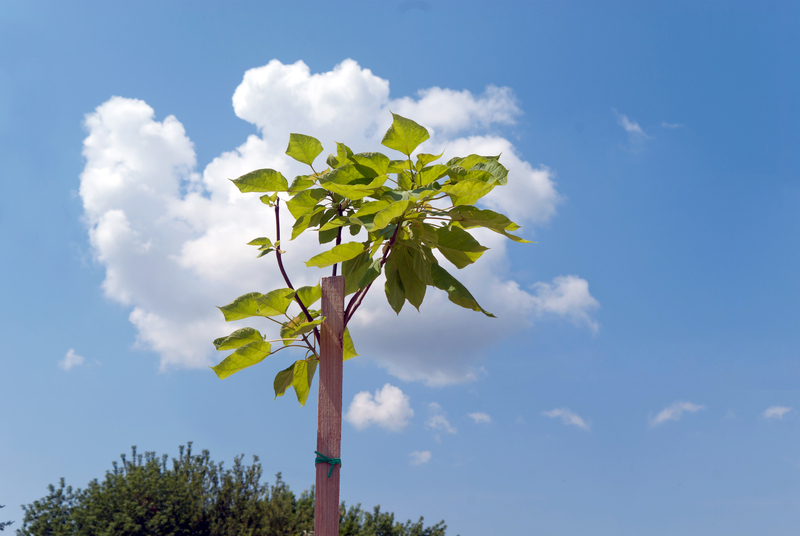Cultivate Joy and Discovery in Your Garden for Kids
Posted on 07/06/2025
Cultivate Joy and Discovery in Your Garden for Kids: A Comprehensive Guide
Would you like to cultivate joy and discovery in your garden for kids? Envision your backyard as a dynamic, educational playground, buzzing with the laughter and curiosity of children. A garden can be a transformative space where kids not only connect with nature, but also develop life skills, creativity, and a love for learning. In this article, we'll explore how to create a garden that sparks joy, fosters discovery, and brings families together around the wonders of the natural world.

Why Gardens Matter for Kids' Growth and Imagination
Gardens are more than just patches of soil and plants--they are living classrooms. Children who play and explore in gardens reap significant physical, psychological, and educational benefits. From improving fine motor skills to nurturing patience and responsibility, the garden is a powerful environment for holistic child development.
- Sensory Stimulation: Gardens engage all the senses--touching soil, smelling flowers, hearing birds, seeing vibrant colors, and even tasting fresh produce.
- Physical Activity: Digging, watering, planting, and harvesting help kids stay active and healthy.
- Learning Opportunities: Gardening introduces foundational science, math, and environmental stewardship concepts.
- Emotional Well-being: Time outdoors can reduce stress and nurture emotional resilience in children.
- Family Bonding: Gardening together fosters connection and meaningful conversations.
Designing a Child-Friendly Garden: Tips for Joyful Spaces
To cultivate joy and discovery in your garden for kids, it's essential to create a space that nurtures their sense of wonder and safety. Whether you have a small balcony, a cozy backyard, or a community plot, the following design ideas will make your garden irresistible to children.
1. Choose Safe and Inviting Plants
- Non-toxic and Edible Choices: Opt for plants like strawberries, sunflowers, peas, carrots, and cherry tomatoes, which are safe for children to handle and taste.
- Variety of Textures and Colors: Mix fuzzy lamb's ear, fragrant herbs, bright marigolds, and tall corn stalks to stimulate curiosity.
- Quick-Growing Options: Radishes, lettuce, and beans show results fast, rewarding patience while keeping excitement alive.
2. Create Child-Scaled Spaces
- Kid-Sized Raised Beds: Build or buy small raised beds so children can easily reach and manage their plants.
- Paths and Secret Nooks: Wind pathways of mulch or stepping stones through your garden. Hide "secret" spots for kids to read, rest, or observe bugs.
- Personal Gardens: Give each child their own little plot or container to foster pride and independence.
3. Incorporate Sensory and Play Features
- Sensory Stations: Setup areas with sand, water buckets, pebbles, and logs for tactile play.
- Mud Kitchens: An outdoor sink with pots and pans allows for messy, creative fun.
- Wind Chimes and Garden Art: Hang wind chimes, mirrors, or homemade decorations to enhance visual and auditory engagement.
Top Activities to Cultivate Joy and Discovery in Your Garden for Kids
Ready to transform your space into a realm of discovery? Here are some hands-on activities to bring joy and a sense of wonder to your kids every time they step outside.
1. Plant a Discovery Garden
- The Rainbow Plot: Plant flowers and vegetables in the colors of the rainbow. Let kids predict which will sprout first!
- Scent Trail: Arrange aromatic plants (like mint, basil, lavender, and lemon balm) for children to explore with their noses.
- Touch-and-Feel Corner: Encourage kids to compare soft, prickly, smooth, and rough leaves and stems.
2. Create a Wildlife Habitat
- Build Insect Hotels: Recycle twigs, pine cones, and bamboo to create miniature shelters for beneficial insects.
- Water for Wildlife: Set up a shallow dish with pebbles for birds, butterflies, and bees to safely drink.
- Bird Feeders and Baths: Attract feathered friends and inspire kids to observe and sketch what they see.
3. Conduct Garden Science Experiments
- Sprout in a Bag: Place a bean between a wet paper towel and a clear bag, and watch it germinate on the windowsill.
- Soil Detectives: Let kids explore the textures and inhabitants of different soil samples.
- Pollinator Patrol: Use a journal to track bees, butterflies, and other pollinators visiting the garden.
4. Harvest and Taste Together
- Pick-and-Eat Veggies: Encourage kids to snack on fresh peas, cherry tomatoes, or strawberries straight from the plant.
- Salad Making: Involve children in harvesting lettuce, washing it, and assembling their own salads.
- Herb Tasting: Chew mint leaves, crush rosemary, or make herbal lemonade as refreshing summertime treats.
Learning Life Skills in the Kids' Garden
Gardens are an ideal environment for cultivating life skills while having fun. When children actively participate, they organically absorb important lessons:
- Responsibility: Caring for plants teaches the value of consistency and effort.
- Patience: Watching seeds grow helps kids practice waiting and celebrating small wins.
- Problem-Solving: Diagnosing why a plant looks wilted or choosing where to plant different seeds hones critical thinking.
- Teamwork: Shared tasks foster collaboration and communication between siblings or friends.
- Creativity: Designing garden art, scarecrows, or plant labels gives space for self-expression.
Overcoming Common Obstacles to Joyful Gardening with Kids
If you're new to gardening or worry about the mess and maintenance, fear not! These tips will help you cultivate discovery and delight in your garden for children without losing your sanity.
- Start Small: One raised bed or several large pots is enough for big fun and success.
- Embrace Imperfection: Gardens are wild by nature--let go of perfection and enjoy learning alongside your kids.
- Use Child-Friendly Tools: Invest in light, ergonomic hand tools designed for little hands.
- Keep Safety First: Avoid sharp tools and prickly or toxic plants; supervise young children closely.
- Plan for Quick Wins: Choose fast-growing plants so children witness immediate results.
Year-Round Ideas to Cultivate Joy and Discovery in Your Garden for Kids
No matter the season, you can keep the magic alive. Here are ideas for all year round to continue fostering joy and exploration in the garden:
Spring
- Sow seeds for cool-weather crops like radishes, peas, and spinach.
- Start a compost pile and let kids observe decomposition.
- Go on a worm-hunt and learn about their role in healthy soil.
Summer
- Host a garden picnic with edible flowers and fresh veggies.
- Build a butterfly puddling station with wet sand.
- Try "garden yoga" together for fun, mindful movement.
Autumn
- Gather seeds for next season with your children.
- Press colorful fall leaves to make garden art.
- Plant bulbs for a magical spring surprise.
Winter
- Grow herbs and microgreens indoors on sunny windowsills.
- Read gardening storybooks together during cold weather.
- Plan your spring garden, sketching layouts and picking plants online or from catalogs.
Choosing the Right Tools and Supplies for Kids' Gardening
To cultivate joy and learning in the garden for your children, you'll want to choose the right gear. Consider:
- Child-sized trowels, rakes, and watering cans - lightweight and easy to handle
- Sturdy gloves - for little hands to feel protected while exploring
- Labels and plant markers - kids can decorate and personalize these
- Magnifying glasses - for up-close discoveries of insects and plants
- Knee pads or mats - make time in the dirt more comfortable
Encourage Storytelling and Journaling in the Garden
Blending literacy with gardening can further spark discovery and delight. Here are ideas to extend learning:
- Garden Journals: Let children record plant growth, sketches of bugs, weather notes, and daily observations.
- Photo Diaries: Give kids a camera to document changes and favorite garden moments.
- Nature Stories: Make up imaginative tales about the flowers, insects, or fairy visitors in your garden.

Grow Connections: Involve Friends, Family, and Community
The joy of gardening grows as you share it. Invite grandparents, neighbors, or classmates to join in special activities. Host a "garden party" to celebrate your harvest or create a small community plot for local families. Kids learn generosity and teamwork as they see the impact of tending a shared space.
Conclusion: Nourish a Lifelong Love of Nature
When you cultivate joy and discovery in your garden for kids, you're sowing seeds far beyond the soil. You inspire curiosity, teach responsibility, and foster a deep-rooted appreciation for the wonders of the natural world. With thoughtful planning and a spirit of adventure, your garden can become a magical place where children grow, laugh, learn, and connect--with nature, with family, and with themselves.
Embrace the dirt under your fingernails, the thrill of each sprout, and the wonder in every bug-hunt. Happy gardening--may your days be joyful, your discoveries many, and your children's hearts forever touched by the magic of growing together!

